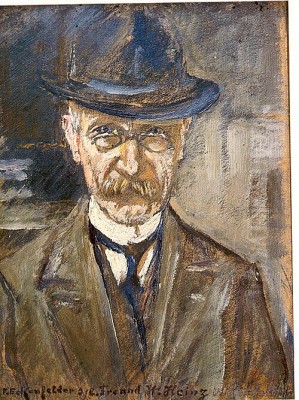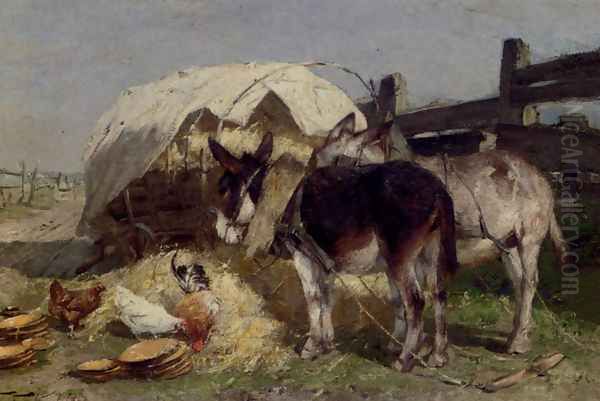
Friedrich Eckenfelder stands as a significant figure in German art history, particularly noted for his contributions to Impressionism during the late 19th and early 20th centuries. Born with Swiss roots but primarily active in Germany, Eckenfelder carved a niche for himself with his evocative depictions of rural life, farm animals, especially horses, and the distinct landscapes of the Swabian Alps region. His work skillfully blends elements of Realism with the light-infused techniques of Impressionism, offering a unique window into the agricultural world of his time. His deep connection to the town of Balingen, in the Baden region, not only provided him with endless inspiration but also cemented his legacy as a beloved local artist.
Early Life and Artistic Awakening
Born in Bern, Switzerland, in 1861, Friedrich Eckenfelder showed artistic promise from a young age. Although details of his earliest training might be sparse, it's known he spent some time honing his skills in Basel before making the pivotal move to Germany. His formal artistic education took place at the prestigious Munich Academy of Fine Arts. This institution was a crucible of artistic thought in the German-speaking world, dominated at the time by the tenets of the Munich School, known for its emphasis on realism, dark palettes, and often historical or anecdotal subject matter.
While at the Academy, Eckenfelder studied under notable figures, though records sometimes vary on exact names, with figures like Oskar Held and potentially others guiding his early development. Crucially, he formed a lasting association with Heinrich von Zügel, a slightly older artist who would become a leading figure in German Impressionism and animal painting. Zügel acted as a mentor and private tutor to Eckenfelder, profoundly influencing his artistic direction, particularly in the depiction of animals and the handling of light. Despite the prevailing academic styles, Eckenfelder began to forge his own path, hinting at the Impressionistic tendencies that would later define his work.
Forging an Impressionist Path

Eckenfelder's artistic journey represents a fascinating transition from the more traditional constraints of 19th-century academic art towards the brighter, more atmospheric concerns of Impressionism. While he retained a strong foundation in realistic drawing and anatomical accuracy, particularly evident in his animal depictions, he increasingly embraced the Impressionist fascination with light and its effects on color and form. His style is often characterized as a distinctly German form of Impressionism, perhaps less radical in its dissolution of form than its French counterpart, but equally dedicated to capturing fleeting moments and the nuances of natural light.
His canvases often feature scenes bathed in sunlight, with careful attention paid to shadows and reflections. The brushwork, while capable of fine detail, became looser and more expressive over time, allowing him to convey the texture of animal hides, the roughness of barn wood, or the shimmering quality of light on a field. Unlike some Impressionists who focused on urban leisure or bourgeois life, Eckenfelder remained deeply connected to the land and its inhabitants. His work exudes a sense of authenticity and empathy for the rural subjects he portrayed, avoiding romanticization while celebrating the dignity of agricultural life and the beauty of the natural world.
The Munich Secession and Artistic Independence
The late 19th century was a period of artistic ferment across Europe, with many younger artists chafing against the conservative dominance of established art academies and exhibition societies. In Munich, this dissatisfaction culminated in the formation of the Munich Secession in 1892. This groundbreaking group sought to break free from the perceived stagnation of the official art scene, championing artistic freedom, individuality, and newer styles like Impressionism, Symbolism, and Art Nouveau.
Friedrich Eckenfelder was not merely a bystander in this movement; he was one of its founding members. His participation underscores his commitment to modernist principles and his desire to exhibit his work outside the confines of the traditional Künstlergenossenschaft (Artists' Association). Joining forces with other progressive artists like his mentor Heinrich von Zügel, Franz von Stuck, Wilhelm Trübner, Fritz von Uhde, Hugo von Habermann, Bruno Piglhein, and influential figures like Max Liebermann (a leading German Impressionist often associated with the Berlin Secession but influential in Munich too), Eckenfelder helped pave the way for greater artistic diversity and acceptance of modern trends in Germany. The Secession provided a vital platform for artists exploring new aesthetic avenues, significantly impacting the course of German art.
Balingen: Home and Inspiration
While Munich was central to Eckenfelder's training and his involvement in the Secession, the town of Balingen in the Swabian Jura region of Baden-Württemberg became his true artistic home. He settled there, and the surrounding landscape, with its rolling hills, agricultural fields, and the distinctive silhouette of the Swabian Alps, became a recurring motif in his work. The town itself, including landmarks like the Zollernschloss (Zollern Castle), also featured in his paintings.
His connection to Balingen went beyond simply using it as a backdrop. He became an integral part of the community, observing and documenting the daily rhythms of life. His paintings often depict local farmers, their livestock, and the specific environment of the region. This deep immersion allowed him to capture the unique character and atmosphere of the area with sensitivity and insight. His long-term residency and dedication to portraying the region endeared him to the local populace, leading to significant recognition later in his life.
Key Themes: Horses, Labor, and Landscape
Eckenfelder's oeuvre is characterized by a consistent focus on several key themes. Foremost among these is his depiction of horses. Unlike artists who might portray horses primarily as symbols of nobility or military power, Eckenfelder concentrated on working farm horses. He painted them with profound understanding and respect, capturing their strength, patience, and essential role in agricultural life. His horses are shown plowing fields, pulling carts, resting at midday, or being tended to by their owners, always rendered with anatomical precision yet imbued with life and character through his Impressionistic handling of light and texture.
Closely related is his theme of rural labor. His paintings often show farmers and farmhands engaged in their daily tasks, providing a glimpse into the realities of agricultural existence in his time. These scenes are depicted without overt sentimentality but with a clear appreciation for the connection between humans, animals, and the land. The landscape itself, particularly the Swabian Jura, forms the essential context for these activities. Eckenfelder masterfully captured the specific light and atmosphere of the region in different seasons and times of day, making the landscape an active participant in his compositions. Other farm animals, like sheep, also feature prominently in his work.
Representative Works
Several paintings stand out as representative of Friedrich Eckenfelder's style and thematic concerns. His early work Sheep in the Pen (Schafherde im Pferch), dating from around 1883, already shows his skill in depicting animals within their environment, focusing on the interplay of light and shadow within the enclosure. Another work capturing a local landmark is Zollernschloss, Balingen (c. 1884-1885), demonstrating his ability to integrate architecture into his atmospheric landscapes.
Perhaps his most famous work is Lunchbreak by the Hut (Mittagspause an der Hütte), also known as The Midday Rest, painted around 1886 or 1888. This piece exemplifies his core themes: farm workers take a humble meal in the shade of a simple structure, while their horses graze nearby. The painting captures a quiet moment of respite during the workday, rendered with sensitivity to the figures and animals, and bathed in the warm light of midday. It reflects both the hardship and the simple routines of rural life. A Farmer Feeding His Horse (c. 1886) is another characteristic piece, focusing on the intimate bond between human and animal. While an early work titled Grizzly Bears at the Pond was cited as winning a prize in 1890, it's more likely this refers to a painting featuring horses, such as Horses at the Watering Place (Pferde an der Schwemme), which aligns better with his known subject matter and earned him early recognition at the Munich Academy.
Eckenfelder in Context: Contemporaries and Influences
To fully appreciate Friedrich Eckenfelder's contribution, it's helpful to place him within the vibrant art scene of his time. His mentor, Heinrich von Zügel (1850-1941), was arguably the most significant influence, sharing a focus on animal painting and Impressionistic techniques. Both were key figures in the Munich Secession. The broader context of the Munich School included prominent artists like Wilhelm von Diez (1839-1907) and potentially Otto von Faber du Faur (1828-1901), who may have been among his teachers or influences at the Academy, representing the more traditional style Eckenfelder evolved from.
Other important figures in Munich during or overlapping Eckenfelder's active years include the celebrated genre painter Franz von Defregger (1835-1921) and the portraitist Franz von Lenbach (1836-1904), both representing the established Munich School. Carl Spitzweg (1808-1885), though slightly earlier, was a master of Biedermeier genre painting whose intimate scenes of everyday life offer a point of comparison for Eckenfelder's focus on specific, relatable moments. Animal painting was a strong tradition in Munich, with artists like Anton Braith (1836-1905) and Christian Mali (1832-1906) also achieving fame, though often with a more detailed, less Impressionistic style than Zügel or Eckenfelder.
Within the Munich Secession, Eckenfelder worked alongside a diverse group including the aforementioned Stuck, Trübner, and Uhde, as well as Symbolist painters like Albert von Keller (1844-1920) and other Impressionists. Looking nationally, Eckenfelder's work aligns with the broader movement of German Impressionism led by the 'triumvirate' of Max Liebermann (1847-1935), Lovis Corinth (1858-1925), and Max Slevogt (1868-1932). While perhaps less famous nationally than these figures, Eckenfelder developed a distinct and respected voice within this movement. Other contemporaries whose works were exhibited alongside his, for instance at the Heinemann Gallery, included August Friedrich von Kaulbach (1850-1920), known for his portraits and historical scenes, and Ludwig von Zychlinski (1816-1900), indicating the diverse artistic landscape Eckenfelder navigated.
Recognition, Honors, and Lasting Legacy
Friedrich Eckenfelder achieved considerable success and recognition during his lifetime. His paintings were popular not only in Germany but were also acquired by collectors across Europe. His depictions of horses and rural life resonated with audiences, and owning an Eckenfelder painting reportedly became something of a status symbol for certain families. His deep ties to Balingen were formally acknowledged when he was made an honorary citizen of the town in 1928. Further cementing his local importance, a street was named after him in 1931 (Friedrich-Eckenfelder-Weg).
His artistic legacy is most tangibly preserved in Balingen. In 1978, the town established a dedicated gallery, the Eckenfelder-Galerie, primarily showcasing his works, ensuring that his contribution to the region's cultural heritage remains accessible. While he may not have received numerous high-profile national awards beyond his early Academy prize, the consistent appreciation for his work and the honors bestowed by his adopted hometown speak volumes about his standing. Today, Friedrich Eckenfelder is remembered as a key representative of German Impressionism, particularly valued for his authentic and skillful portrayal of animals, especially horses, and the rural landscapes of the Swabian Jura. His work offers a valuable artistic record of a way of life that has largely vanished.
Conclusion
Friedrich Eckenfelder navigated the transition from 19th-century academic traditions to the burgeoning modernism of the early 20th century with skill and a distinct personal vision. As a founding member of the Munich Secession, he actively participated in the push for artistic innovation. However, his most enduring contribution lies in his sensitive and light-filled paintings of the subjects he knew best: the working horses, the farming communities, and the landscapes of the Swabian Alps around Balingen. His blend of Realist accuracy and Impressionist atmosphere created a body of work that is both historically informative and aesthetically engaging. Through his dedication to these themes, Eckenfelder earned a respected place in German art history and a permanent home in the cultural memory of the region he so lovingly depicted.